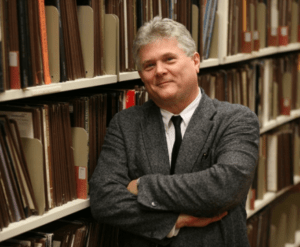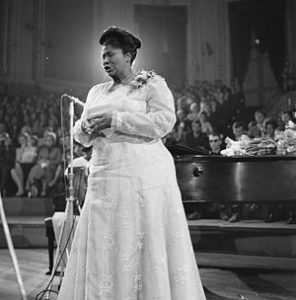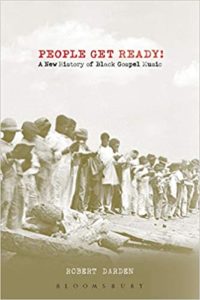Black Gospel music is a foundational ingredient in every popular music genre in America, and with the opening last week of Baylor University’s Black Gospel Archive and Listening Center, music that has long been accessible only to music scholars and historians is now available to the public.
 Located on the garden level of Baylor’s Moody Memorial Library, the archive and listening center marks the beginning of a new chapter for the Black Gospel Music Restoration Project, which was launched in 2006 and is the world’s largest initiative to identify, acquire, digitize, catalog and make available America’s fast-vanishing legacy of vinyl from the “golden age” of gospel music.
Located on the garden level of Baylor’s Moody Memorial Library, the archive and listening center marks the beginning of a new chapter for the Black Gospel Music Restoration Project, which was launched in 2006 and is the world’s largest initiative to identify, acquire, digitize, catalog and make available America’s fast-vanishing legacy of vinyl from the “golden age” of gospel music.
The new archive and listening center features storage space for thousands of physical items, including LPs, 45rpm discs and cassettes, as well as researcher computer stations and a custom work desk. The centerpiece of the space is a Framery brand sound isolation pod with high-end audio equipment and a full keyboard for researchers who want to play along with sheet music or recordings from the collection. The space is reservable for researchers, students and the general public.

Robert Darden
The archive and listening center opened on Nov. 12 with a day of events that included performances by Heavenly Voices Gospel Choir and a lecture, “Why Gospel Music Matters,” presented by the project’s founder, journalism professor Robert Darden, and Robert Marovich, founder and editor of the Journal of Gospel Music and a major collector whose materials have been loaned to Baylor for digitization and inclusion in its online database.
Speaking after the event, Darden said the “golden age” of gospel music runs roughly from 1945 into the 1980s.
“Not that equally incredible music hasn’t been released since, but this was when it was such a focus of the churches and such a focus of Black life and entertainment. When African Americans only had a half dozen newspapers in the country, owned no radio stations, no TV stations, very few were published (authors) in any form, music was the one avenue of expression,” he said.
“It’s the golden age because it influenced so much of American popular music. It was so vibrant and so vital. You’d be hard pressed to find any white or Black artist in the U.S. or U.K. who didn’t borrow something from it. And it corresponds with the golden age of the blues and soul music as well and the incredible explosion of African-American creativity.”
Beginnings
Darden traces his own interest in Black gospel music to his growing up as the son of a career Air Force officer. Unlike the other military services at the time, the Air Force was integrated when it was founded, he said, which meant his friends and playmates in the base housing were both Black and white.
“Those were my neighbors. I was going in and out of their houses like they were in and out of mine,” he said. “I’ll always remember their parents singing or they had these songs on their little rinky-dink hi-fi players, and somewhere down the road that was such a happy, joyful thing and it became the soundtrack of my life.”
Darden also noted the role his parents played in his leanings toward Black gospel music.

Mahalia Jackson
“When my dad got promoted to captain in 1960 — I would’ve been 6 years old — he got a raise and he went and bought our first hi-fi player, and he had enough money for three LPs: a Perry Como LP, a movie themes LP, and Mahalia Jackson’s Christmas album. And according to my parents, I played Mahalia over and over.”
After earning degrees focusing on journalism, arts and education from Baylor and the University of North Texas, Darden started his professional career as arts and entertainment editor for the Waco Tribune-Herald and later was gospel music editor for Billboard magazine. He has been teaching at Baylor in some capacity since 1988 and in 2006 joined the full-time faculty of the Department of Journalism, Public Relations & New Media.
 Darden has authored more than two dozen books, many on the theme of Black gospel music and its role in American history and the Civil Rights Movement. In 2005, as he was completing People Get Ready: A New History of Black Gospel Music, his frustration in the scarcity of resources boiled over into action.
Darden has authored more than two dozen books, many on the theme of Black gospel music and its role in American history and the Civil Rights Movement. In 2005, as he was completing People Get Ready: A New History of Black Gospel Music, his frustration in the scarcity of resources boiled over into action.
“A lot of the music I was writing about I couldn’t listen to, couldn’t hear, couldn’t find in every way I knew to look. So I polled some collectors I’d met when I was at Billboard, and they said, ‘Oh yeah, about 70% of this music is unavailable. It’s in landfills, it’s in private collections, it’s tied up in litigation, it’s owned by big corporations who don’t think there’s any money in it.’”
Darden said that realization angered him and he wrote an opinion piece and sent it to the editors of the New York Times. In it he said, “It would be more than a cultural disaster to forever lose this music. It would be a sin.”
Against all odds, the Times published his piece. And if that wasn’t shock enough, the next day Charles Royce, a Connecticut businessman, called, and as Darden recalls, “He said, ‘You figure out how to save it and I’ll pay for it,’ and so immediately I went to Baylor Libraries and I’ve been working with them ever since.”
Preserving history’s voices
Royce’s generosity in 2006 paid for a digitization studio and the first scanners and the first couple of employees. Baylor Libraries provided workspace as well as more people power. Once the word got out, the records started coming in — not just music but recordings of sermons as well.

Robert Marovich
The largest donor of music to the project has been Marovich, who Darden said has been sending 45s at a rate of 50 a month for 10 years. That has been joined by donations from far and wide — from other large collectors but also from individuals who have sent just a few pieces of what he describes as “old battered pieces of vinyl that were probably going to the landfill otherwise.”
“We think more than 60% of our holdings are the lone copy,” he said. “We have no way of proving that because there’s never been a discography of gospel music, unlike every other genre. But we’re pretty sure a good chunk of what we have are one-off or the only surviving copy.”
When a record arrives at Baylor, it is cataloged, cleaned, scanned and digitized. It then is stored for future research and listening or sent back to the owner if it is a loan.
“Most of what we have sounds better now than it’s ever sounded because we do clean them,” Darden said. “And for the ones that we put on streaming, we take out the pops and hisses. We don’t do that on the archival version. We just want to hear it,” he said.
Darden said the technology is such that even if a disc is worn and the sound is bad, a microscope can be used to find the best side of the groove to record from.

Gospel musicians, a woman playing the tambourine and a man seated and singing into a microphone, on Newberry Street or Peoria Street, near 14th Street, Chicago, circa 1971. (Photo by James Newberry/Chicago History Museum/Getty Images)
“Most people’s needles on their old-fashion record players bias one way or the other, so the V-shaped groove would be worn down on one side but on the other side there’s still a pretty good signal. So they can tweak their needles to hit the side that has the best signal,” he explained.
As well, they can digitize discs that are warped, oversized and even recorded at the wrong speed.
“Some gospel music in particular was pretty cheaply pressed and recorded at wrong speeds, which changes the sound and the pitch a little bit,” he explained. “We’ll of course make an archival copy of that, but then we can also find the right speed that was meant so it goes in the right key like it was supposed to.”

Henry Louis Gates with Robert Darden
Darden said that as the collection has grown, evidence of what historian Henry Louis Gates Jr. calls a “double voicedness” has become prominent, particularly in the 45s of the early 1960s where the record carried two messages. The practice is not unlike the original protest spirituals from before the Civil War.
“We knew about some, but we didn’t know the sheer volume of it,” he said. “When you think about somebody walking around Birmingham in 1963 with a Dorothy Love Coates 45 they had just bought at the neighborhood furniture store, the A side is the hit side, and on the B side right under the noses of those racist sheriffs and everybody else is a song that says, ‘Ain’t no segregation in heaven,’ or ‘I believe Martin Luther King was right,’ or a song that name-checks all the other civil rights sites of that moment, which the Birmingham paper wasn’t covering, they weren’t getting it in the New York Times.”
Perfect timing
Darden said it is just coincidence that the archive and listening center has opened at a time when conversations about racial justice and equality are at a fever pitch.
“I’d like to say I was that smart, but it does seem auspicious, doesn’t it?” he said. He recalled watching funerals of members of the Black Lives Matter movement, “and time and again I was astonished to see people 20 and younger singing these songs, songs that even their parents would have been a little young for the classic Civil Rights Movement. It would have been their grandparents.”
Darden said there are more books and documentaries on Black gospel music coming out now than in the 30 years he’s been writing about it. Many of those books have been researched at Baylor.
 “When I first started back in 1999 on People Get Ready, I had maybe seven or eight other books to draw on, and that was the reason I wrote it: there was no history of gospel music. And now we’ve got three or four coming out in the next month or two.”
“When I first started back in 1999 on People Get Ready, I had maybe seven or eight other books to draw on, and that was the reason I wrote it: there was no history of gospel music. And now we’ve got three or four coming out in the next month or two.”
Darden said the archive and listening center was made possible in large part by Baylor alumna Ella Prichard and the Prichard Family Foundation, who like Charles Royce and others have stepped up and contributed when it was needed.
“Somebody has always been there,” he said. “That’s why I know it’s God’s hands on this, because I’m not nearly that smart to have figured it out. But God puts these people in a place where they get why it matters and they want to be a part of it.”
More to come
Darden said the new center — with its graphic displays and state-of-the art listening booth — is not the culmination of the Black Gospel Music Project’s work but the next step in an ongoing journey.
“You worry about leaving a legacy anywhere,” he said. “My worry has always been that even though presidents change, deans change and old fat white guys die, that this would become such an integral part of Baylor that even if they lost interest in it for some ungodly reason, that it would be self-sustaining and that it would continue to do what it was designed to do, which is preserve and make accessible these voices that have not been heard.”
 Darden recalled that during the opening events, Jeffry Archer, dean of Baylor’s libraries, told him there is room to grow if needed, and in Darden’s estimation the center will continue to grow as more music is found. Every few days he gets word from the center that a new box of vinyl records has arrived, and “it’s sort of like Christmas” when he walks from his office to the center to check it out.
Darden recalled that during the opening events, Jeffry Archer, dean of Baylor’s libraries, told him there is room to grow if needed, and in Darden’s estimation the center will continue to grow as more music is found. Every few days he gets word from the center that a new box of vinyl records has arrived, and “it’s sort of like Christmas” when he walks from his office to the center to check it out.
“I don’t mind not knowing every artist, because there’s a lot of one-offs, but what scares me is when I start getting several LPs by the same label — like Greenwood, we got one the other day — and I’d never heard of it, and that means there’s this whole other line of Greenwood LPs out there that nobody knew about. There’s the happiness, and then there always ends up being a little urgency to get those before they end up in a landfill somewhere. Every voice matters on this.”
Darden said the opening of the center is not just an opportunity to invite more scholars and gospel aficionados to come and “play with the toys,” as he likes to say, but it’s another chance to invite the public to join the preservation effort by donating or loaning their old recordings rather than throwing them away.
“If you do have vinyl that fits our criteria, whether it’s sermons or singing, we’ll pay for the shipping,” he said. “And we’ll return the original if you like. Just let us harvest that music before it’s gone.”
Jeff Hampton is a Baylor University journalism graduate who is a freelance writer living in Dallas.
Related articles:
Baylor endows new academic chair in study of Black worship
Baylor professor’s quest to preserve golden age of black gospel lands in Smithsonian
‘Freedom songs’ make a reprise during this year of protests
Greg Garrett, Baylor prof and BNG columnist, awarded Baugh grant for research on race and media


